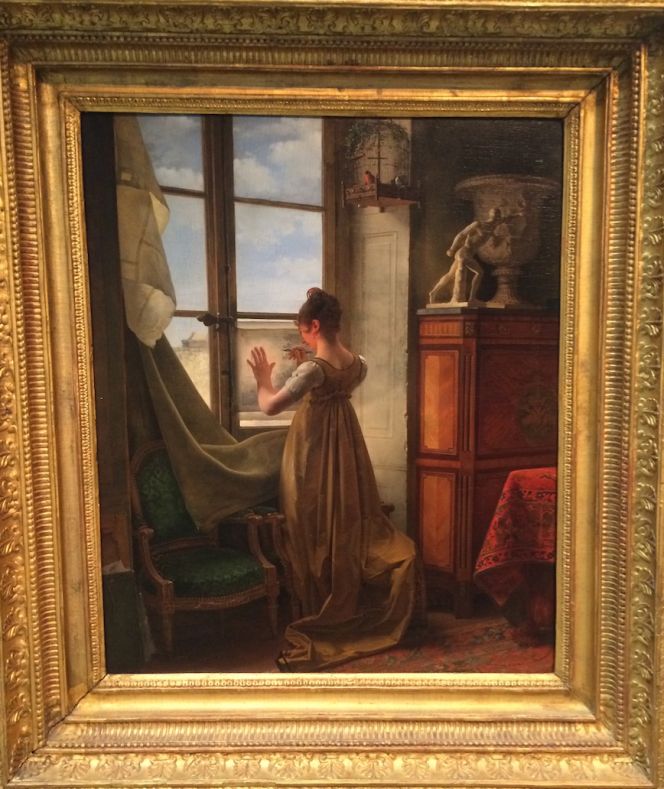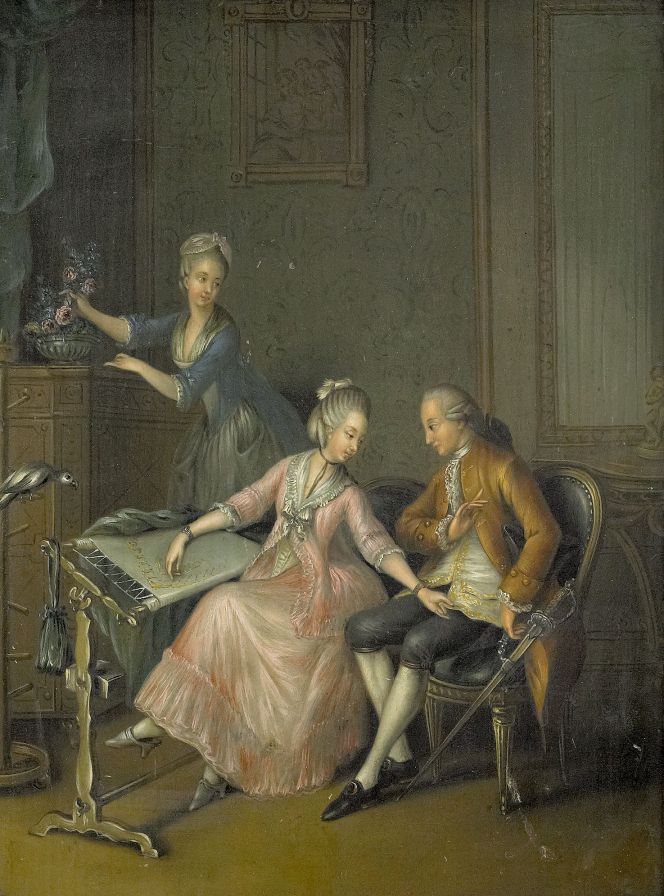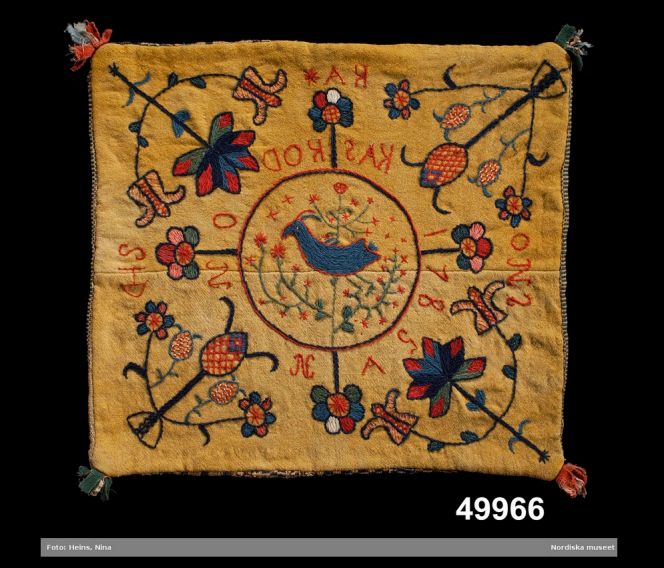ikfoundation.org
The IK Foundation
Promoting Natural & Cultural History
Since 1988


 Crowdfunding Campaign
Crowdfunding Campaignkeep knowledge open, connected, and growing on this textile history resource...
TRANSFERRING EMBROIDERY DESIGNS
– in the 18th Century
The tradition of transferring designs for free embroideries was well-known in the 18th century. Professional workshops, as well as domestic embroiderers, had the possibility to draw the pattern freehand with chalk, charcoal or ink on the fabric, but more commonly, designs were transferred onto linens, fine muslins, woollens, etc, with various methods from printed or hand-drawn paper patterns. Inspirations for such motifs could be patterns from books or magazines, sharing decorative ideas between friends, copying ready-made embroideries in one's circle of acquaintances or via earlier gathered designs of individuals or workshops alike. This study will give some illustrative examples of such methods used in the domestic sphere, together with a few notations from contemporary letters. An image taken from an Italian pattern book printed already in 1527 gives a historical view – from an 18th century perspective – of these skilfully made sketches for embroidery.
 The French artist Martin Drolling (1752-1817) painted ‘A Girl Copying a Drawing’ in a wealthy interior about 1790 to 1800, which gives a good understanding for how an embroidery design was transferred on to a piece of gossamer thin cotton, silk or linen quality. Exhibited at the Pushkin Museum in Moscow, Russia. Photo: The IK Foundation, London (June 2015).
The French artist Martin Drolling (1752-1817) painted ‘A Girl Copying a Drawing’ in a wealthy interior about 1790 to 1800, which gives a good understanding for how an embroidery design was transferred on to a piece of gossamer thin cotton, silk or linen quality. Exhibited at the Pushkin Museum in Moscow, Russia. Photo: The IK Foundation, London (June 2015).Evidence for the traditions of transferring embroidery patterns may be studied from art, correspondence, and literature that originates from the well-to-do and bourgeoisie, such as Italy, France, Great Britain, and Sweden. This could either be for the purpose of decorating a young lady’s future dowry, including clothing and textile furnishing, or as educational needlecraft or a leisure activity. Embroidery and sewing at home were also considered a suitable source of income for women from the higher classes, if the family happened to be short of money temporarily or for more extended periods.
![The more than two-hundred year older publication ‘Buratto, a Book of Embroidery’ printed in 1527, demonstrates quite clearly how a woman in four different ways transferred an embroidery motifs to a fabric. (Paganino, Alessandro, Il Burato, Libro de Recami, 1527 [1518], p. 87).](https://www.ikfoundation.org/uploads/image/2-embroidery-664x834.jpg) The more than two-hundred year older publication ‘Buratto, a Book of Embroidery’ printed in 1527, demonstrates quite clearly how a woman in four different ways transferred an embroidery motifs to a fabric. (Paganino, Alessandro, Il Burato, Libro de Recami, 1527 [1518], p. 87).
The more than two-hundred year older publication ‘Buratto, a Book of Embroidery’ printed in 1527, demonstrates quite clearly how a woman in four different ways transferred an embroidery motifs to a fabric. (Paganino, Alessandro, Il Burato, Libro de Recami, 1527 [1518], p. 87).The Swedish textile historian Ernst Fischer made interesting observations in his research on free embroidery from 1971 of the above-depicted woman. Among other facts, he noticed: ‘The four images show how a woman transfers a pattern for an embroidery to the preferred foundation. On the first, a woman sits by a frame, which rests on two trestles. The pattern is placed under the fabric. A candle below the frame makes the pattern visible on the fabric. In the second image, the woman uses a frame placed in front of a window, whose light gives the same effect as the burning candle in the first image. In the third image, the woman has dotted the pattern onto the fabric with a dusting of charcoal; in that manner, she has transferred the pattern onto the fabric. In the last image, the design of the pattern is sketched without any tools directly on the fabric.’ Additionally, Fischer made several comparisons from poems and correspondence in upper-class homes touching on the subject, which have given evidence that the same transferring techniques for embroidery designs were in use in 18th century Sweden – and had probably been for quite a long time. One letter in particular also proved that it was not necessarily the embroiderer her/himself who sketched the pattern, revealed when Count Claes Julius Ekeblad (1742-1808) wrote to his wife Brita Margareta Horn af Ekebyholm (1745-1791) about a fire screen. ‘Your screen is becoming exquisitely beautiful after the drawing. At Hedda’s [sister to countess Piper] I have arranged to stretch the satin in the frame; so Mr Sparrgren [the young pattern draughtsman] not will stain it’ (February 11th, 1782). Quotes in translation from the Swedish.
 This domestic interior from a wealthy home dating 1780, depicts a detailed view of a free embroidery in a frame. The motif was pre-sketched on the fine silk fabric and stitched with a gold-like thread. Maybe the lady was comparing her work with the vest worn by the young man! Oil on canvas by Niclas Lafrensen the Younger (1737-1807). (Sold by Stockholms Auktionsverk in 2012, unknown ownership).
This domestic interior from a wealthy home dating 1780, depicts a detailed view of a free embroidery in a frame. The motif was pre-sketched on the fine silk fabric and stitched with a gold-like thread. Maybe the lady was comparing her work with the vest worn by the young man! Oil on canvas by Niclas Lafrensen the Younger (1737-1807). (Sold by Stockholms Auktionsverk in 2012, unknown ownership).Perforated paper drawings in pencil for embroidery dating from the early 18th century have also been preserved. Chalk for darker fabric or charcoal for lighter coloured fabric was applied/rubbed and, in that way, transferred onto the textile material through the needle holes. Research published by Anna Maja Nylén also explains that the Nordic Museum keep around 50 paper designs of this type in their collections. These drawings once belonged to the Countess Beata Jacquette Ribbing and were made in the period 1700 to 1730 by an unknown, but skilled draughtsman. Visual or written proofs of these transferring techniques for embroidery can almost entirely be traced from sources linked to individuals of the wealthy or bourgeoisie. Still, possibly these various methods were also known in the farmers’ communities in southern Sweden, for example, where the tradition of various free designs with woollen yarn on woollen cloth was widespread, like on the travel cushion illustrated below. Besides charcoal or chalk, potato flour was also commonly used to line out the patterning on the woollen cloth in these communities.
 Woollen travel cushion with a free embroidery from 1785, originating from Ystad in southernmost Sweden. The chosen motif of this well-preserved textile was transferred on to the fabric in an unknown manner. However, one can be sure that the design was prepared with the assistance of some type of paper original before the stitching with woollen yarn, due the complexity and exactness of the design. It may also be emphasised that the window or candle techniques were not possible since the cloth is of a thick and non-transparent type – which was primarily used for warm skirts in the area. (Courtesy of: The Nordic Museum NM.0049966).
Woollen travel cushion with a free embroidery from 1785, originating from Ystad in southernmost Sweden. The chosen motif of this well-preserved textile was transferred on to the fabric in an unknown manner. However, one can be sure that the design was prepared with the assistance of some type of paper original before the stitching with woollen yarn, due the complexity and exactness of the design. It may also be emphasised that the window or candle techniques were not possible since the cloth is of a thick and non-transparent type – which was primarily used for warm skirts in the area. (Courtesy of: The Nordic Museum NM.0049966).Sources:
- DigitaltMuseum. (Search words: ‘Woollen embroidery).
- Fischer, Ernst, Skånska yllebroderier i fria sömsätt, Malmö Museum 1971, pp 25-27
- Nylén, Anna-Maja, Hemslöjd, Lund 1969, pp 218-221. (English edition, Swedish Handcraft in 1976).
- Textile Research Centre, Leiden (Online source) Alessandro Paganino & PDF of the pattern book Il Burato, Libro de Recami (1527).
Essays
The iTEXTILIS is a division of The IK Workshop Society – a global and unique forum for all those interested in Natural & Cultural History.
Open Access Essays by Textile Historian Viveka Hansen
Textile historian Viveka Hansen offers a collection of open-access essays, published under Creative Commons licenses and freely available to all. These essays weave together her latest research, previously published monographs, and earlier projects dating back to the late 1980s. Some essays include rare archival material — originally published in other languages — now translated into English for the first time. These texts reveal little-known aspects of textile history, previously accessible mainly to audiences in Northern Europe. Hansen’s work spans a rich range of topics: the global textile trade, material culture, cloth manufacturing, fashion history, natural dyeing techniques, and the fascinating world of early travelling naturalists — notably the “Linnaean network” — all examined through a global historical lens.
Help secure the future of open access at iTEXTILIS essays! Your donation will keep knowledge open, connected, and growing on this textile history resource.
been copied to your clipboard




– a truly European organisation since 1988
Legal issues | Forget me | and much more...
You are welcome to use the information and knowledge from
The IK Workshop Society, as long as you follow a few simple rules.
LEARN MORE & I AGREE







